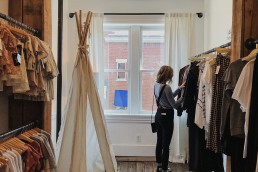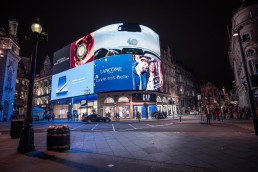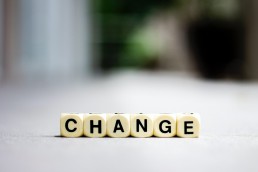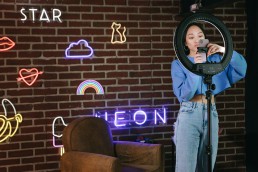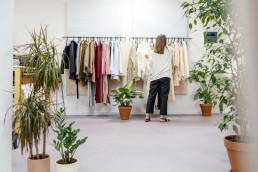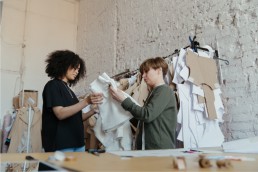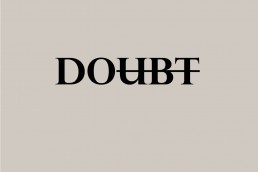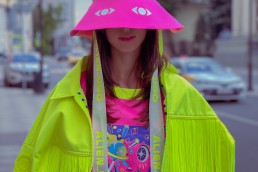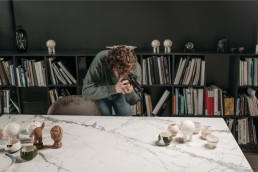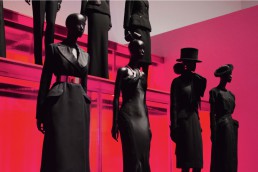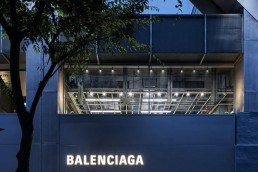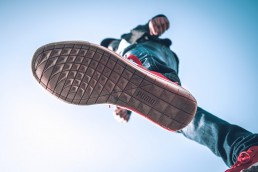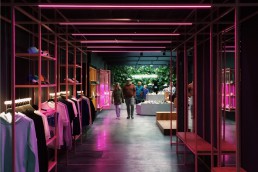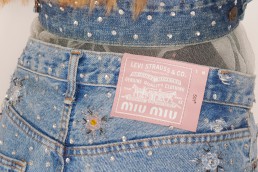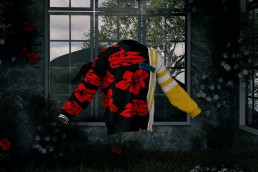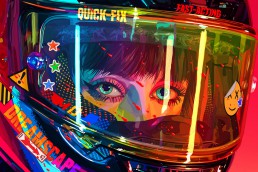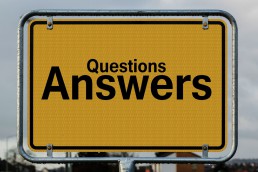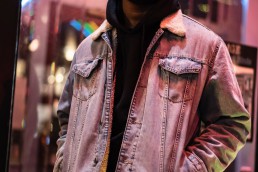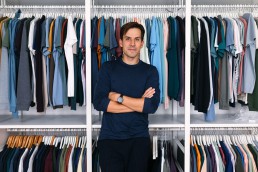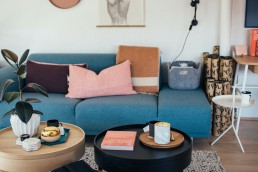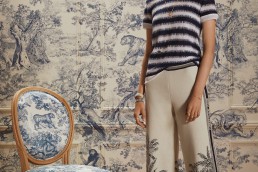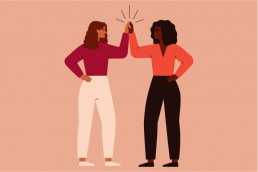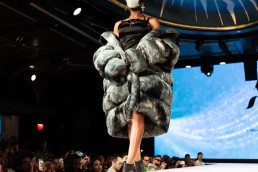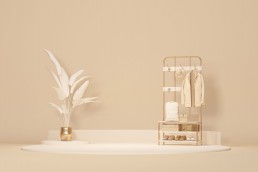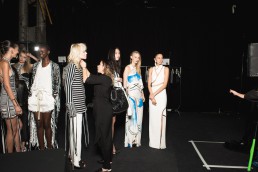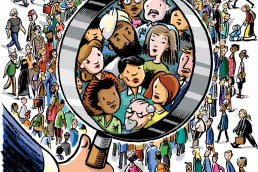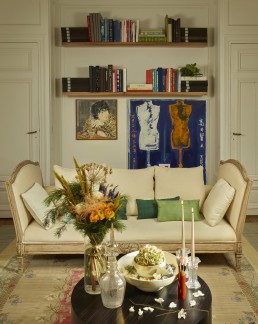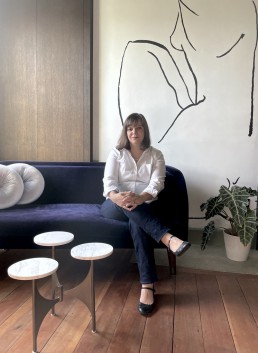A Life Through Design: Kenzo Takada and the Art of Living
Japanese by origin, Parisian by choice, the late fashion designer created a world full of color for an everyday wardrobe and an impeccable taste expressed through interior design.
Kenzo Takada’s legacy remains, undoubtedly, as fresh as it was back in the day. He was the first Japanese designer to show in Paris in 1970 and splashed the establishment with textures, folklore, and volumes for an uncomplicated, light and casual way of life. He arrived to Paris five years earlier.
With his creations made with fabrics suitable for kimono making, he created an intimate language of using Japanese materials with an unexpected and unusual treatment for the time. Born in Himeji in post-war Japan, Takada entered the fashion world as one of the first male students in the prestigious Bunka Gauken College in Tokyo in 1958, a brave thing to do.
Working as a freelance illustrator in Paris the ‘capital of fashion’, he sold drawings to houses like Louis Féraud and ELLE Magazine -the covers came later- to stay ahead. But his journey really started when, knowing he could not compete with famous couturiers and big budgets of the time, he simply dared to be different, innovating and creating something really unseen.
In a modest corner on Galerie Vivienne, Jungle Jap was born, a modern fashion space, combining a boutique clothing offering with artistic happenings that changed, forever, the way a fashion store should be. In this context, Takada was creating the foundations of the contemporary ‘concept store’ as we know it today.
The mythical store interiors were inspired by the canvas ‘Le Rêve’ of Henri- le douanier- Rousseau, a fantasy jungle decor, exposed today in MoMA. With a special attention for colors, details, flowers and motifs, Kenzo understood all youth expectations, creating fashion’s according to the zeitgeist and establishing a very powerful visual trademark.
The Foundations of a Worldwide Aesthetic
One of the most significant of Kenzo’s contributions to fashion was a cultural miscegenation approach, honoring his Japanese heritage and world’s folklore, with a playful yet colorful-mix and match inspirations.
He conceived volume as a form of freedom for the body against flat cuts. His eclectic vision and imagination were exposed through all of his work. With Moroccans Djellaba, Indian robes and saris, the Mao style from China, Vietnamese jackets and trousers and long and wide Slavic skirts.
In a way, he was re-introducing orientalism brought by Paul Poiret in the early XX century. He was too a devotee of color, textures, prints, exotic fabrics, and the joy of living.
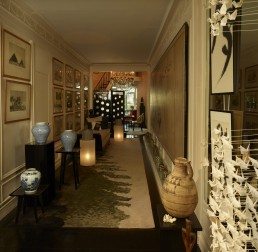
©Pearl Metalia – Thomas Hennocque
“In my collections, it is spring all the year”
Interior Design and Fashion: A Life Through Objects
After stepping down from fashion in 1999 -LVMH acquired his brand in 1993-, he started a vast collection of objects and traveled; to have the essence of the world inside his Paris home over the last fifteen years of his life.
A year ago, he was launching K三 a luxury home and lifestyle brand, an interior design venture founded by him and partners Jonathan Bouchet Manheim, Engelbert Honorat, with the expertise of creative designer and interior designer Wanda Jelmini of T&J Vestor and Missoni Home.
His approach to interior design was an experience, a classic style and the use of noble materials. K三 is an extensive yet meticulously curated collection of chairs, sofas, tables, rugs, home textiles and accessories, a colorful ode to life with great craftsmanship blending a modern twist. The meaning of the name K三 has its roots in the Japanese kanji.”三”, which means the number “three”, as well as balance and harmony.
His multicultural brand identity combined with the foundational goal of inspiring cheerfulness, joy and poesy using bright colors, bold patterns, and an audacious lust for life.
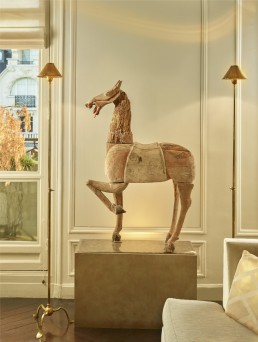
©Pearl Metalia – Thomas Hennocque
“For me to create is to give pleasure and happiness to others, and the freedom to be myself”
An Exuberant Collection to Auction

©Pearl Metalia – Thomas Hennocque
In the heart of Saint Germain quarter, in a light-filled Haussmann style apartment re-designed by his friend the architect Ed Tuttle, lays his ultimate collection of more than 600 items including Art Deco furniture, paintings, objects, crystal chandeliers and works of art (Asian, Pre-Columbian, and Tribal), with influences of the East and West, reflecting an exuberant and personal gaze on interior design.
Artcurial will pay a final tribute to the multi-talented artist, with a special auction in May 2021. “The collection reveals the eye of this genius in the world of fashion and interiors, he knew how to bring different cultures together”, comments the auctioneer Stéphane Aubert, regarding a large wooden Hinoki horse from the Han period, a Buddha torso dating from the 3rd century, a Pleyel grand piano by Ruhlmann and thirteen photographs by William Eggleston, among other remarkable pieces.
Tableware and porcelain will be featured, as well a selection of Japanese stoneware, Murano glassware and a Harcourt crystal service by Baccarat marked with the designer’s emblem.
As Takada always stated, “everything starts with a drawing, Nehru, Botticelli, Rashômon by Kurosawa, Romania, Africa, China, Mickey Mouse. It can all be a source of inspiration”
A brilliant man who dedicated his life to art, culture, fashion and interior design.
Fernando Aguileta de la Garza
Interior Design, a Conversation with Charlotte Vandersleyen, Founder of BUSILIS Studio
An insightful interview with BUSILIS studio director, Charlotte Vandersleyen, about spaces, architecture and the keys to understand interior design processes.
Interviewer: What is the state of interior design and the changes in home design and decoration since the shifting brought about by the pandemic around the world?
Charlotte Vandersleyen: During the pandemic, things have been a bit different business-wise for everyone. People have less projects, they have been producing less content and even have problems to photograph spaces. This year everything has been going down, all the design events, less to invest in prototypes and so on. Suppliers haven’t launched new collections… That’s usually a source of inspiration; to see what other people are doing.
I think of creativity as a muscle, it’s something that you need to stimulate and you need to exercise to keep being good at it. Because of the situation, I believe people have been refining the trends that have been there already for the last few years rather than reinventing the wheel.
I: What kind of redefinition or visual trends you might say?
CV: It shifted towards some kind of architectural detailing, more than decorating. People are more focused on alignment in the building, preserving elements, I think the structure itself has become more of a feature in the last few years. In general, I would say just simple and elegant rather than over the top. In furniture, a bit more organic, round shapes, more like a nice object to have in your home rather than something just functional, a more sculptural approach.
In terms of materials, the natural looking – I do not mean only timber or metal but also glass or cement, concrete-, things have been quite trendy the last few years. And ‘terrazzo’ has made a comeback, a huge comeback. All these things that you don’t need to decorate afterwards, you don’t need to paint them, they just are nice naturally.
And then in terms of colour, white is becoming fashionable again. I am happy about that because I am really sick of Magnolia [laughs]. White colour exposes everything rather than disguise it, as a single colour, it makes the details stand out, definitely a slightly more contemporary take.
Also, pastel colours have been a trendy thing in the last two years, and not only applied on the walls but to the whole space.
“I might as well open my own studio, because at the end of the day, if you are not making your own dream happen, you’re making someone else’s“
I: How did you start in this business?
CV: I studied Architecture and I was working in Portugal and then in Belgium, then at one point, my husband and I moved to the U.K. I was working freelance, but each time I was talking to recruitment firms, they would always look at my interior design portfolio and say, ‘Oh! that’s really good. Can I put you down for that other interior design job instead of this?’
I found it more fun because you have more creativity in interior design without having all the paperwork that goes with architecture.
I ended up continuing doing interiors for a while and started in a small creative studio with a permanent position. I stayed there for two years because it was quite fun and a nice little team. But then, I just realised that actually I knew more than I thought I did and I was running the whole project. And then I thought, well, why am I doing that for someone else while I could actually do this for myself?
That is how I founded BUSILIS studio. There is a sense of achievement that you get from doing something for yourself, which I have to admit, is quite rewarding. I am doing both Interiors and Architecture. Soon I will be launching a brand-new furniture collection. This is something that I’m doing on the side. It kind of opens up opportunities that I didn’t think of before.
I: What are the most important elements to think of when you get involved in a new project?
CV: We must not forget that, although we are trying to make the space look beautiful, the clients need to be live in it, it needs to be used on a day-to-day basis. It’s not a conceptual artwork. We are not talking about something that is just nice to look at, you need to be able to use it as well.
Being practical, functionality is really the number one of my list of priorities, the most important part. I listen to the client’s needs and determine the layout.
You have ask them, for example, how do you see yourself using the space? Who is going to use it? You have to think if they have children or if they are alone, what is their lifestyle? What kind of function will they perform in there? Not everyone is using the space in the same way. Having that initial conversation, you will make sure that whatever you come up with as solution will be the best for them.
Also, the second most important thing is what you are starting with, what is already existing in the building. Being true to the original building and respecting / preserving original features when there are any. The situation in London is, in fact, that most of the projects I have are renovations. You do not want to destroy the whole thing to build something new. I am mindful of what was originally there and respecting the architecture.
I think architecture and interior design are kind of linked, it’s not one thing and the other. Decoration, on the other hand, can be replaced like wallpaper or a sofa, but if you get rid of the fireplace or if you get rid of the original tiles in your project, they are gone forever.
“I believe the things that you change thanks to interior design can have a long-term impact on the way people live in their spaces“
I: How do you create an inspiration concept?
CV: Usually, I start looking at the constraints in the building, for example: Is your building listed? Is it protected? Is the plumbing in the right place? I think that because of the renovation kind of context in London, that would define a lot of the layout in the first place, even before aesthetics.
The ‘program’- which is what the client wants and needs, the way they are going to use it, the activities that they want to perform in there- adds a second layer of complexity to the concept : making the space functional within the constraints. I always propose a couple of options: what the client initially asked for and what I think would tick the same boxes but would make the most of the space. People are often amazed by their space’s potential, they just hadn’t thought of doing these changes to their space.
In terms of style, it depends a lot on the client’s preference, if they like something more modern or more traditional. I will usually sleep on it after doing the survey and taking pictures of the existing space and by the time I am starting to work on the project I have got a pretty clear idea of what I would do. I always take the existing features into consideration and the client’s budget.
I gather some images and I try to get them to understand my vision by showing them images of existing projects, you kind of collage different ideas, you sketch, you show materials, you have a conversation. It’s a bit of going back and forth, it’s not unilateral, it’s a process, you end up getting something really unique and bespoke for that client in that space.

I: In project development, how do you manage that idea into the reality of the job?
CV: As I said before, functionality and previous research of the actual space is a must. The idea never goes first, I think it’s the opposite. The concept is taking the constraints, features, functionality and aesthetic of the place into consideration making the most of the existing. In the London market it is quite rare to get a blank canvas.
We are not applying a random image to any place, like creating “minimalism”, “victorian look” or “industrial”, I guess for some other projects with more freedom or different objectives it might be like that but, for most projects, I think it’s the other way. Applying ideas that are bespoke to this particular project is then a very natural process.
“On a construction site, the less unexpected things you can have, the better results you get“
I: What would you say are the key skills to organise a project?
CV: You have to be able to communicate your vision with the team. The people who are going to implement this, builders, and so on. The real key is to do everything really, really well, detailing, produce a clear documentation, make sure that every single piece that you are putting in there will have a reference, you must have a template for everything.
Being well organised and tag everything, every piece, every piece of furniture, light switch, colour palette, you get to the point where you need to make sure that whatever you do, everyone knows what they are doing because it’s all clear, a well-crafted plan.
On site, you need to supervise, making sure that things are done properly in the first place so you don’t have to redo them. At the end of the day, it’s saving money and time for everybody.
I: What is the most rewarding part of doing it?
CV: It depends how much the client lets you in to reach the full potential of their place. If they trust me enough, I will make sure that they get the best solution for their space and for the best budget, I have their best interests in mind.
If they let you do what you think will be best, you usually get the spectacular end result and seeing the product materialise, all these efforts were worth something because the end result is amazing.
And when the clients look at it and say ‘Oh, it is better than what I could have ever imagined!’, you get recognition for your professional work.
Fernando Aguileta de la Garza
Influencer Marketing: A Conversation with Natalia Cortazar, Founder of The Good Egg.
Management advise, ethics and brand values inside influencer marketing strategy. An insightful interview with young entrepreneur Natalia Cortazar and the future of the influencer business.
Interviewer: What are the most important steps in order to create a successful influencer marketing strategy?
Natalia Cortazar: We need to think that our target is the audience of influence not the influencers themselves, that is quite an important thing to have in mind when creating a successful influencer marketing strategy from the start. I mean, the selection of those influencers is strategical, their type of content and their reach numbers, of course those steps are important, but it is way more relevant to understand their audience, all the variables that move the fandom, as taste, way of life, interests and how they search for content.
As for the talent, any strategist needs to remember that influencers are people, in the first place, not just media robots. We are not dealing with just an algorithm; they have relevance in their area and people listen to them. It is not just paid media or advertising, it is not like that.
You have to put the people at the forefront to succeed. The strategy approach has to be more human.
I: Then, in your view, comparing influencer marketing with paid media is not accurate?
NC: Yes, they are not the same thing. Influencer marketing is more than just paying for an ad. If you work with an influencer to promote a product, service or an initiative it is not limited as placing a fixed ad on a website or television. What marketers and people don’t see is that an influencer gives us production, because they create the content; and strategy, because they are also creative and propose original ways to showcase the product/service (although we brief them). They do the distribution in the channel, upload the content in their social media platforms, plus as clients, we may be able to reuse their content in the brand’s official social media accounts.
If you compare influencers CPV’s (cost per view) rates sometimes yes, the fee will be higher because it includes a way more things than just displaying an ad, as in an online banner or a page in a magazine.
“What works for certain brands may not work for the other one. You need to adapt your strategy”
I: Can an influencer help to build brand awareness? Or do you think its purpose is more action-oriented, as boost selling or activating promotions?
NC: They can raise brand awareness, absolutely, I think they are better in that rather than just impulsive purchases. Although, it depends on the sector, for some brands influencer marketing can boost sales, but it depends on what you want to achieve with a certain type of content creator.
I worked for Public Health in England years ago. We were promoting health tests with an influencer marketing strategy, so every woman, about twenty-one and twenty-five in the UK should go and get tested to avoid Cancer. In this case, the immediate action was not selling. Instead, we wanted to make a point, raise consciousness about it, a discussion. And that was the goal, not only track success based on sales.
I: How did you start in this business?
NC: I was working on marketing agencies for a few years and then I was promoted from Senior to Director, to Head of Area, in three years. I was very close on the agency side and taking care of clients. Then, I started to engage with debates in professional social media, like LinkedIn, about influencer marketing topics and I started viewing things from a different perspective. So, I decided to take the lead and create my own project.
I called it ‘The Good Egg’, because, in English this means ‘made of a good person’, a nice person to hang around with. Then, we started working for little agencies, which is something as a team we do, as well as white labelling, to work for big agencies that need help. I’m not an ego person, what I care about is that our work is good and people are happy. We have worked for Hackett, Pepe Jeans, Adobe, Hype Collective, Decathlon, among others. At the moment we’re looking after Stereo, which is a massive audio social media platform.
“As a brand you try to associate with values, doing it you are thinking in a long-term strategy, that’s brand awareness“
I: What are the key skills every influencer marketing manager should have to succeed in the field?
NC: It depends what part of the business you are. If you are in management, you may need to have a lot of accountability, because you are going to be the direct contact with the talent, with the agency or the client, you need to be trustable person, a people’s person.
Also being really aware of what is going on through different social media channels, what’s new, what’s coming, what are the platform changes, even if you don’t personally engage in the platforms. You have to be in the loop.
I: How can you generate authentic value in a market (influencer economy) that sometimes is banned as fake and prone to fabricating false narratives?
NC: Some of the influencers are generating a variety of content and value through different topics such as entertainment, education, inspiring content, fashion content, for free. You cannot really demand that the influencer has to be authentic –just for you– because, at the end of the day, they can be whoever they want. They have certain values, certain narrative and a way of doing things that engage with their audience.
Obviously, fake influencers eventually will lose their influence and status because no one is going to follow their content anymore and it is easy to track which of them are being serious and professional and which of them are not. So, it is up to them to play this game, but it is completely up to the audience to follow or unfollow.
“If we identify something that feels homophobic, racist, or not quite right, we should flag it, always”
I: What ethical practices do you think are needed in talents, agencies or brands? How do you see the future of the business of influence?
NC: A little bit more welcoming, in the business side, everyone should be more responsible and respectful. First, the pay gap, it is very important that we show some kind of benchmark numbers around influencer marketing, it is beneficial for everybody, brands, talents, agencies.
Second, honesty and transparency in brand values and commitments. I fully support Black Lives Matter, also, everything that is going on with the trans community, with black-trans community, with the LGBT community. Respect is so important to have in mind on not to use any of those minority groups or communities as a token.
In order toward a more ethical world, we should try to be inclusive. Every time we receive a brief, if we identify something that feels homophobic, racist, or not quite right, we should flag it, always. And also, we should check out the talent that has not had any allegations against those issues. It is important for the brand and for the job.
I: What do you consider to be the most passionate thing about your job?
NC: The joy of working with people and seeing your influencer marketing campaigns out. When people are seeing it on YouTube, or discussing it on television or someone on a newspaper is doing an article because they think it is really good, that is exciting.
Fernando Aguileta de la Garza
What You Need to Create a Successful Influencer Marketing Plan
In order to be ahead in digital marketing strategies, influencer marketing is the most popular way to connect and engage with clients and communities. How can you create a good planning strategy based on values?
The influencer economy is transforming all communication and marketing opportunities as social media channels can reach practically every space on the planet thanks to technology. According to a benchmark report from Influencer Marketing Hub “from a mere $1.7 billion in 2016, influencer marketing is estimated to have grown to have a market size of $9.7 billion in 2020, and is expected to jump to $13.8 billion in 2021”.
The number of platforms and agencies focused on influencer marketing have increased over the years in order to offer a professional strategy and work closely with social media talent. The report also states that 90% of managers believe influencer marketing to be an effective form of marketing, having 59% of them a stand-alone budget for content strategy spending from their marketing departments.
The number of Google searches for influencer marketing has increased 1500% in the last years, so, as a brand, to be digitally present means to be engaging with followers and consumers, having the right conversations, spotting latest trends and play it from a different perspective to be memorable. A digital brand profile is not enough.
The Brand Strategy Behind Influencer Marketing: It’s All About Values.
Brands must acknowledge that selecting the right influencers for their marketing target based on quality, instead than just the numbers of followers, can pay off.
“Identifying influencers aligned with the brand’s identity and values is mandatory, no matter how many millions of followers an influencer has, if they are not 100% aligned with the attitude and values of the action, it makes no sense to work with them, as their audience will notice that the action is not consistent with the influencer’s personality” states Pedro Barrios, Press and PR manager for an international brand.
Coherence, authenticity, and identification is what creates commitment in a successful plan, “to make sure the influencer’s affinity with the brand is legitimate, which can be translated by two points: do they organically like the brand? Would they wear it if there wasn’t a paid deal behind?”, says Raquel Vieira, PR & Comms manager for Lacoste for the Iberian region. Both agree that if the influencer represents the brand’s core values is a win-win scenario.
For Susana de Castro, Southern Communications Manager for Puma, is all about personalization and definition. “Without clear objectives there is no measurable success, I believe this is the biggest key and at the same time the biggest challenge we face. I don’t believe in magic formulas that work for everything, but I believe in strategic communication designed ad-hoc for each client and occasion”. In other words, the key is to set measurable goals to achieve clear objectives in order to draw the right strategy for the plan.
“It is not the same to communicate a new product launching on the market for a millennial target, as it is to communicate a rejuvenation campaign of our brand to reach Gen Z” Susana de Castro, Southern Communications Manager for Puma.
Branding as a Communication Driver in Social Media Marketing.
Influencer marketing and social media content can boost brand awareness, drive sales in some particular cases -if a campaign goes viral-, and become a point of reference for the customer to understand what is what you have to offer and why it is related to them. The ultimate goal is to build a community, as the most important thing, and it’s valid for all kinds of brands or companies. Know your client, listen to what they have to say and track all relevant insights you might get into the process.
Barwise and Meehan, consider four fundamental qualities shared by brands with great orientation to social media in their innovation article for Harvard Business Review:
1.- Brands offer and communicate relevant customer promises. Their messages are clear.
2.- Brands continuously try to build trust by delivering on that promise. That means they focus on identity.
3.- Brands drive the market by continually improving the promise. They are action-oriented, being better all the time is their mindset.
4.- Brands seek further advantage by innovating beyond the familiar. They are constantly out of their comfort zone as they try to get creative, honouring the promise.
From Micro to Macro Influencers and Press: A Completely Changing Landscape in Fashion Media Planning.
With objectives in mind, to start any communication plan, we must carefully select all the tools the brand might need to offer a sharp vision and relevant purpose within a communication strategy.
Brands usually consider a full approach, which means to integrate all communication tools and marketing resources into a well-crafted strategy, sometimes using digital, sometimes traditional media, other times using both. It depends on the segment, the price and even on budget.
As print media ads declined in the last years in favor of digital ads or influencer marketing, that does not mean that, for fashion and lifestyle brands, a magazine is no longer an option. “If you want to generate brand awareness, both print and digital media can be equally important. Both, need to have -ideally- the same identity as the communication action you want to develop”, Barrios comments, as he had worked with fashion magazines for 15 years, but recognizes the efficiency of digital, “if you want to impact a younger target, the influencer may be the fastest action to reach it, although if you want to build brand value long term, magazines will always be a good option”
In Vieira’s point of view, influencers can help build awareness and also drive sales if the product is affordable. “If the products are less affordable and more high-end, I see them as a piece in the puzzle, they can tell the brand narrative and represent an important action of a 360º plan. On the other hand, we see key opinion leaders which are also considered micro influencers to be highly influential in terms of conversion, so ROI (return of investment) in this case is high”.
“If it is for a mass market, it can serve both purposes as macro-influencers clearly are even replacing traditional media” Raquel Vieira, PR & Comms Manager for the Iberian Region at Lacoste.
Influencer Marketing, Global Plans Versus Specific Markets Activation. What is the Winning Route?
With a global pandemic scenario, brands are resetting all past notions of how they should act in a global environment, because nothing makes sense anymore. With limitations in international travel, retail, and physical events the investments on digital had risen drastically.
Even major shifts in social media platforms had happened, developing new products and tools to get consumer attention such as Facebook and Instagram Shop, including Shoppable Instagram Reels, or TikTok’s Shopify integration to video ads. All trying to get people’s attention as we spend more time home or we try to connect with friends more often.
According to Reuters, Snap Inc., owner of photo-messaging app Snapchat beat Wall Street analysts’ estimates for both user growth (55%+ in daily active users mainly outside US or Europe) and revenue to 265 million in 4Q. As a proof that social sharing and digitally connectedness are still on track.
But not all strategies equally succeed in all markets, as the importance of local has dominated the current social conversation. “If we are talking about big brands, the answer is the combination: be “GLOCAL”. It’s important to us to be keeping up with trends, let’s say, in the U.S. but at the same time, at least for European market, we want to feel identified with icons that speak to us in our language, delivering a more natural message for our environment”, de Castro argues. In her opinion, it’s important to combine a global profile with the proximity and authenticity that a local profile offers, in terms of engagement, it’s good for a communication strategy.
Vieira agrees, because a micro/opinion leader activation can give the brand credibility. “In streetwear, for instance, a certain type of influencer can be huge in the U.S market but hyper niche in other ones”. As she states, in influencer marketing or in all communications strategies, culture and tradition are important, “you can’t judge a book by its cover, you must understand the audience codes because what can be seen as unacceptable in one market, might be completely standard in another, and this refers to dressing style, tattoos, language, and so on”.
“It is easily detectable when an influencer buys likes or has no engagement at all with their audience, the bubble has burst” Pedro Barrios, PR & Press Manager.
Ethics and Authenticity: Valuable Content Through Influencer Marketing.
Brands, agencies and talent, a three-way team to generate creativity and unusual thinking to deliver value. Any business relationship must be based on trust, at the end, if internal teams can get along and work efficiently, the results will be seen from the outside and we can measure success from different perspectives not only about numbers.
Personal skills are required to understand the ecosystem and pick up the right influencers or brand ambassadors, “you have to know them personally to see if these people ‘vibe’ with the brand’s values, so do your research, see their engagement, see who in your network follows them, analyze their speech”. Authenticity cannot be fabricated, “and as for talent or agencies I believe they should stick to their style and what they do, don’t say yes to everything, on the long term, less is more” Vieira consider.
For Barrios, the fake influencer bubble has burst, “I think that a good stage has been reached between brands and talent agencies by giving real data -audience and reach-, trustful talent is appreciated”.
Key people as a communication tool, bring their charisma and lifestyle to the brand, establishing a mutual relationship based on shared values, similar criteria and common interests. Same thing applies when dealing with influencer marketing, “when we rely on influencers, we rely on content generators, and if we ignore their creativity, we lose the value of authenticity”, as freedom and unorthodox content is part of the communication strategy nowadays. “We need to be transparent and coherent about storytelling, and who we work with it is a two-way job” de Castro concludes.
Fernando Aguileta de la Garza
Proximity Hubs: An Absolute Must for Retailers
Strengthening the last-mile storage and distribution system is the strategy deployed to provide first-class customer service, at the lowest cost and as fast as possible.
The future of supply chains lies in a locker: the end point of the last-mile storage and distribution system where the fashion and beauty industry will seek to get their products to customers as quickly as possible, and at the lowest price.
This venture goes by the name of “proximity hubs”. Booming in Europe and seen as the next major retail trend in North America, things are just getting started in Latin America. “They are far more than just a fad. They represent a solution, and are in essence a necessity,” according to José Ruiz, Supply Chain and Operations Advisor at the international consultancy firm KPMG in Mexico.
In late 2020 and early 2021, online sales charts posted double-digits growth worldwide, leading analysts to go from wondering if this behavior would be temporary – stemming from pandemic-induced lockdown – to arguing that it represented a structural shift in changing consumer habits.
Ruiz explains that this means that primary logistics, which move merchandise from production centers in heavy-duty units, has switched to distribution centers near high-density population areas for delivery in smaller vehicles. This has given rise to the concept of “microhubs” or self-service storage, models invoking the P.O. boxes of yesteryear: areas fitted with several automated lockers, where brands deliver merchandise for buyers to collect. Lockers are opened with a numerical code sent to their cell phones.
“It’s a quest for the most efficient and sustainable model, economically and environmentally. It’s a logistics phenomenon,” says Juan Flores, director of Market Analysis and Consulting for Newmark Knight Frank (NKF), a global real estate services firm. Growth has been so strong, he adds, that it could soon aid real estate restructuring in large cities, with spaces being created for proximity hubs, one of the changes urban areas will witness as part of the e-commerce boom and all its related services.
The movement is global. In addition to being retail-driven, where the fashion and beauty sectors play leading roles, it is also changing the way things are done in tech. It’s even making inroads in cities with high population density, lacking large spaces for logistical operations.
“For example, in Tokyo, Paris, Seattle or New York, we’re seeing (these proximity hubs being created) that are multi-level and operated with robotic arms, which take products from shelves, and humans arrange them to ship consolidated deliveries,” explains Gerardo Ramirez, Regional Industrial Director at JLL Mexico, a global real estate services company specializing in business properties.
In the Lap of Luxury
The first fashion industry companies to invest in the proximity hubs-based logistics model include Hermès (Allan, France), Louis Vuitton (Sainte-Florence and Beaulieu, France) and Gucci (in Scandicci, Italy).
Ruiz points out that these models have an overriding goal: “wow” factor. To be competitive and more enticing for buyers, businesses seek to shorten delivery times. “It all depends on how aggressive the value proposition generated for customers is. If 24-hour delivery is promised, this defines the storage and distribution set up. When planning this, companies must establish their intended value proposition.”
Louis Vuitton is leading the way here: according to its Paris stock exchange reports from 2018, the firm developed a proximity hubs strategy to meet 7-day delivery times. This sounds standard in peak digital boom but remember that in 2014 their delivery times were 7 weeks. These dropped to 2 weeks in 2018 and now it’s just a week. Such a response capacity is key in an industry that must react extremely quickly to trends and to customer demand for new clothes and accessories.
Vietnam, China and India are renowned for their industrial capacity for manufacturing footwear, clothes and bags, among other accessories. However, the need to bridge the gap and ensure faster deliveries, reduce logistics costs, and move inventory faster has already aggressively driven this operating model in other regions.
The “Latin America Industrial Market” report for NKF (Q1 2020) notes that the main income-producing operations in São Paulo in Q2-2020 came from companies in the transport, storage and logistics sector (45%), e-commerce (43%) and industrial sectors (12%). Most of this activity is registered within a radius of 30 to 40 km from the state capital, confirming a trend of companies moving to the city.
Mexico City is taking its first steps towards this delivery specialization model. “The Last Mile Boom” analysis, also from NKF, highlights the $40 million investment made by the developer and landlord O’Donnell in the Gustavo A. Madero community: 38,765 m² to meet growing e-commerce sector demand and last-mile needs. Ramírez adds that the company is already analyzing these alternative development companies such as Prologis and Corporate Properties of the Americas.
“The Latin American market is at an early stage (in this trend) but is moving quickly, mapping a sustainable course as long as e-commerce continues its exponential growth,” Ruiz notes, adding that Europe has already witnessed this process, with environmental factors also driving growth. This is because self-service storage and mini-hubs reduce traffic involved in home deliveries, require shorter trips and can be done in light, electric vehicles, which pollute less, pursuant to regional demands.
If the trend is so clear, and facing medium-term consolidation, what comes next? Including this factor in reverse logistics, according to Ramírez: “The next step involves having logistics in place enabling an item to be easily returned when consumers don’t like the color or size. The chain must be efficient when delivering products, but also when picking them up and returning them to the distribution center,” he adds.
Three Key Pillars to Get Started
The fashion and beauty industries can get more out of last-mile logistics. JLL México’s Regional Industrial Director highlights that the agile supply chain can generally be used for faster deliveries in cosmetics and fashion. How?
- Define the value proposition. Logistics planning begins when the desired value proposition has been defined. Analyze to establish whether this is a major differentiating factor affording a competitive advantage in delivery and turnaround times.
- Strategic areas. Next, identify the clusters of areas where the most orders are generated: where the highest volume of purchases take place and how often these are requested. Specialized software exists to help interpret these big data, for enhanced strategic decision making.
- Assess the service cost When designing the core strategy, establish how much the hub will cost in the following key areas:
- Storage
- Primary and secondary logistics distribution
- Last-mile and last delivery execution
Mildred Ramo and Verónica Cervantes
8 Tips to Polish Your Atelier's Elevator Pitch
When opportunity knocks, answer; prepare a short, punchy business presentation to attract the investors required to capitalize your endeavor.
The modern world moves fast. Time is money and we love things that make our lives easier. Newsletters are succeeding due to this chronic shortage of time; events that would take a couple of hours to read up on have turned into 10-minute summaries, ending daily meetings after 15 minutes. Investors are busy, they fully understand how valuable their time is and don’t like wasting it. Entrepreneurs must understand this. Therefore, elevator pitches have emerged as a popular idea that business schools are exploring further.
Imagine bumping into the company’s creative director or the head of a VC fund in an elevator. You have this short encounter to persuade them to take a glance at the latest sketches in your collection or your makeup app prototype. How would you get their attention?
This is the basis of the elevator pitch. Start building it now, drawing on your business proposal’s most eye-catching and promising data. “This pitch concept is a must in business and networking,” according to Francisco Martínez, a lecturer at the National Autonomous University of Mexico (UNAM) School of Economics, “and it’s particularly useful in highly competitive sectors, such as fashion and beauty,” he notes.
The experts we interviewed highlight a series of key points that every elevator pitch should include.
“At investment forums, these meetings take place all the time in the corridors. A good pitch, less than 60 seconds, is a must. What makes you different? What’s your business all about?” Adds Diego Martinez, director of the Center for Entrepreneurship and Business Development (CEDE) at the Ibero-American University in Mexico City.
Recommendations for Building Your Pitch
Spanish designer Moisés Nieto, winner of the National Fashion Prize for new value in 2017, and who has run a brand under his own name for ten years, reveals that to build valuable messages, he and his team spend a large chunk of their time engaging with customers. This young creator’s formula involves clients from the beginning of the creative process. “We ask for feedback on designs, provide options for choosing colors and materials, with the aim of including customers in the creative process, to make them feel part of the brand’s universe, to create a connection and trust. This will always grow stronger if they like the product.”
A wide range of tools are used to communicate with his audience: satisfaction surveys, newsletters and lots of direct engagement via social media. “Our best customers are the first to hear the latest news and we offer them preferential treatment.” Being a niche brand gives them opportunities for direct engagement with customers, which is considered more difficult for larger brands.
Insights drawn from customers will be useful when pitching to potential investors, even if you have less than a minute to get them across in an elevator.
Another tool providing permanent material for identifying sales opportunities to make the business more attractive involves having a good database for understanding customers and knowing whether they come back to the store, according to Lourdes Madrigal, who has experience as a floor manager for firms including Saint Laurent and Miu Miu in Mexico.
“The repurchase rate is the most interesting tool we use. This reveals whether marketers are doing their job effectively and if they are making the right claim.” This indicator measures how often customers return to buy and whether they purchase the products that sales assistants have suggested. This tool is useful for both in-store sales and e-commerce, provided “you have a good database.”
All these data help to identify powerful figures and indicators to snag a potential investor. The goal is to leave with the chance of a future meeting, where a business plan can be presented in greater detail. To make a spontaneous pitch work: “Focus on the benefits, not the features,” concludes Francisco Martínez.
7 Steps for Building a Pitch
After pooling the most attractive points, structure them as follows:
- Confirmation or question. Pitch a question or a key piece of information supporting your proposal to draw the listener in.
- Credibility. Identify yourself: who you are and what you do.
- Which problem are you identifying? Experts think this is the key point: which need have you identified and how will you solve it.
- What’s the solution being offered? Explain the innovation proposal. What makes you different? Perhaps the tech, the production materials, etc.
- Main benefits. In a word or two, define what you’re selling, and what your brand/idea’s main benefits are.
- Has it been validated? If you’ve run a social media campaign or presented the project at a fair, tell the investor, who’ll want to know if there’s demand for it.
- What do I need? By the end, the listener must fully understand what you want. This could be investment, a partnership with their company or consultancy.
Daniel Blanco
Leadership for the Fashion Industry During the Digital Boom
Finding your way in times of technological expansion and economic challenge requires a blend of traditional management skills, technical know-how and an entrepreneurial mindset.
The pandemic, lockdown and travel restrictions have radically changed how we work and consume. Business leaders must develop new skills, or enhance existing talents, to survive and thrive in the new ecosystem.
A study published last year by the research team at CaixaBank, one of Spain’s leading financial institutions, found that the number of people working from home peaked in the Iberian nation just a few months after the pandemic began. It remains to be seen whether the trend will continue in the long term, but so far it has ushered in dramatic changes in the way we work in most parts of the world.
For example, “Universalizing access to digital technologies to address the consequences of COVID-19”, a report from the Economic Commission for Latin America and the Caribbean (ECLAC), reveals that traffic and the use of teleworking solutions shot up by 324%. According to research conducted by a group of economists from the MIT Sloan School of Management in the United States, over half (50.02%) of US workers now work from home.
The video call app Zoom is a fine example, having posted jaw-dropping returns in 2020. According to Statista data, the company earned $USD777 million, its all-time high, rising from $USD169 million in the same period in 2019. Other apps enabling video calls, such as Google Meet and Microsoft Themes, are also among the most downloaded for 2020.
In this new, remote working world, video calls and online shopping – which skyrocketed 71% worldwide in the second quarter of last year according to Salesforce – managers must channel energies into certain increasingly important hard and soft skills.
Diego Martínez, from the Center for Entrepreneurship at the Ibero-American University in Mexico City, cites “innovation” as the top soft skill a leader requires in uncertain times. Only the most flexible companies, best able to quickly adjust their business model to the new times, will survive.
Innovative Leader: The Benchmark in 3D Printing
Although seeming almost paradoxical, the fashion industry, which prides itself on exploring the latest trends and is modern by definition, suffers more than might be expected when adapting to the new times and assimilating digitalization. “While digitalization in fashion is nothing new, the digital introduction and development has always been exceedingly slow, much slower than other fields,” according to María Calvo, an authority and professor in the use of new technology in fashion at a design and fashion school in Madrid. Albeit slowly, the sector has plunged into digital world in every industry process, from creation to sales. Certain professional profiles are needed to oversee these upgrades.
To ensure, sustain and continue progress, leaders open to the use of technology are essential. For instance, Calvo believes that the first major digital tool to hit the fashion world emerged in the 80s with the advent of computerized pattern making. This continued in the early 90s with automatic cutting machines. Both the cutting machines and software were extortionately expensive, meaning “only the big brands could afford it.” This slowed the process of implementing new tech. Consequently, an oligopolistic market formed, only broken in the last 10 years with the proliferation of new programs, finally accessible to smaller stores and independent brands.
However, this would not have been possible without managerial profiles combining (the managers themselves or their teams) creativity and technological openness with fashion industry knowledge. Nowadays, 3D garment simulation is the technology arousing the most interest. “In recent years, 3D in fashion has gained widespread adoption, specifically since the US consultant Calypso published a report in 2017 noting that 3D technology was the area where fashion companies were investing the most. That’s when we all realized what was going on,” says the professor from the European Institute of Design.
This tool saves time and resources, facilitating communication between members of the design team. Previously, any changes required a great deal of time and material, whereas now, it only takes a few minutes, and no fabric is wasted. “It’s also extremely useful for showcasing and selling clothes before manufacturing them,” Calvo adds, highlighting sector demand for a highly specific profile currently in short supply: pattern designers skilled in the use of 3D garment simulation programs. “These people don’t exist yet!” she exclaims.
Eduardo Sánchez, director of the IED School of Fashion, mentions 3D simulation first when addressing digital skills: “It helps purchasing planning, making production more efficient.” But there’s more. For sales, marketing and communication processes, the key to success lies in “SEO positioning, powerful apps and augmented reality, such as online fitting rooms ensuring there are no returns because the customer bought the wrong size, which accounts for most cases.
Sánchez believes the profiles involved in undertaking these tasks, as well as “user interface and user experience,” are in high demand across the sector.
He also highlights the importance of big data and artificial intelligence to understand how customers buy and about product presentation. This must all be moved to social media, “where we depend on external tools with their own rules.” Customers must have: “A good e-commerce experience, because a good product and even a good price no longer guarantee anything. Brands offer much more.”
Hard and Soft
Skills inherent to the fashion industry and those concerning the digital economy, which is so mainstream these days, account for part of the ideal combo. These are “hard” skills. Other, “soft” skills come from assertive management.
Javier Valdez Alejandre, a lecturer at the Faculty of Accounting and Administration at the National Autonomous University of Mexico, underscores the importance of ethical leadership, where leaders guarantee fair working conditions for their employees. Martínez highlights other highly sought-after soft skills in modern companies:
- Analytical thinking (decisions based on hard data)
- Active learning and learning strategies (what you learned a year ago may not be up-to-date)
- Creativity, originality and initiative
- Critical thinking and complex problem solving.
“Fashion is suffering a great deal from technological adaptation, but several companies are benefiting an awful lot from online shopping and home delivery,” the professor notes. User experience design, marketing, sales and video production skills are also highly sought after during the pandemic.
Daniel Blanco
Are You Building Your Brand? Avoid Common Pitfalls
Brands are the heart and soul of all life and style companies. Their creation requires professional development.
In fashion, like all markets, brands are intangible assets that can even become a company’s most prized possession when synonymous with quality and reliability. Therefore, creating a brand is an important task requiring professional development to avoid the most common design pitfalls.
Creating a brand compared to a product offer represents a competitive advantage, because garments or other items can be copied. However, brands create an identity, meaning consumers are buying more than just a dress, a jacket or a pair of trousers. They’re buying a promise. This may be quality or durability, and everything that goes into a product’s creation, invisible to the customer.
Emiliano González, a fashion marketing consultant, reveals that one of the most common pitfalls when building a brand is believing that identity focuses exclusively on graphics (a logo, label or slogan). Instead, it goes much deeper, touching on psychology and semiology. “You have to build a persona, or an identity based on deeper knowledge. People must make mental associations between images and concepts when shopping,” he explains.
González adds that to build the brand, deep knowledge of the target market is essential, along with the values required to achieve positioning goals. “If you’re going to buy a cotton t-shirt, you won’t pay more than 200 Mexican pesos ($USD 10) because you’re only going to pay for the tangible, the piece of fabric that’s cut out and sewn together. If your competitor does the same, people will buy the best garment at the best price. People aren’t buying the brand here,” he explains.
The second most common pitfall is creating a brand based on the here and now, not the future. Brands must be universal and timeless, to be passed down to our children or grandchildren in the future. “When creating fashion brands, trends come and go and brands die,” he notes.
To avoid the most common pitfalls in this process, the fashion consultant recommends following these five steps when choosing a brand name:
- Keep it short.
- Make it memorable.
- Make it euphonious or pleasing to the ear. It should be associated with the service or product for sale.
- There should be a relationship, even if not direct, with certain mental images people can associate with the product or service.
- Ensure the chosen name is unregistered, i.e., that no one has registered it before.
Go That Extra Mile
Another pitfall is, when you have a successful product, wanting to create a brand. This is not impossible, but involves a longer, more complicated process. Brands used to be the designer and their mystique. People went directly to the designer to buy a product based on quality and design, then recommended it.
“When they began industrializing, fashion brands realized that, ultimately, brands outlive the designer, and when a designer leaves for whatever reason, the brand remains valuable. An outsider takes the brand over and continues the founder’s legacy. For instance, this is the case with Chanel. Coco Chanel passed away, but the brand was so iconic, so intricately connected to what she believed, designed and loved, that the people who took over continue her legacy. They ask themselves: what would she have done? Then, they take action,” González adds.
However, he explains that because perceptions are obviously somewhat ambiguous, a brand identity manual must be built. This is not free from perceptions. It’s a brand DNA rulebook, which evolves and gets updated, while the brand remains the same. It’s universal and timeless.
Several companies neglect brand building, and in many cases they aren’t doing too badly. But they’d do better with it. People often don’t appreciate this process, but sooner or later it must be built.
Araceli Calva
Call-to-Action: Sustainability and the Fashion Agenda in 2021
What are the covering topics in sustainability around fashion business? Moreover, what is the role of non-profit organizations in a brand’s commitments? And what are the current goals to achieve?
Sustainability has raised more attention than ever, mainly due to cultural changes in the past few years, a worldwide pandemic, and a new way of thinking regarding new business models. However, facts are not pleasant in an endemic consumerism culture and fast rewarding desires.
The production of apparel and footwear goods is set to increase by 81% by 2030, according to Boston Consulting Group. Bearing in mind that almost 10% of all human kind carbon emissions are linked directly to the fashion industry.
Producing polyester, a fibre in more than 60% of the worldwide produced garments, emits two to three times more carbon than cotton, as stated by a finding of World Resources Institute. 20% of global wastewater comes from the fashion industry, the textile dyeing practice is the second largest polluter of water globally (it takes 2,000 gallons of water to make a pair of jeans), and approximately one garbage truck of textiles is landfilled or burned, every second.
In their article “Trends in the Fashion Industry. The perception of sustainability and circular economy: A gender/generation quantitative approach”, Gazzola and several authors observe that fashion uses more than 98 million tons of non-renewable resources annually (producing, finishing, fertilizing). 93 billion cubic meters of water are added to waste, impacting directly on drought events, therefore 1.2 billion tons of CO2 are generated besides 500 thousand tons of microplastic fibers poured into the oceans.
What is -Really- Sustainable? Or is This Greenwashing?
Kate Fletcher defines sustainable fashion as a strong and nurturing relationship between consumer and producer, to provoke a process of “reconnecting us with nature” and “with each other”. One of the main topics is to create a product that starts a debate and invoke a deeper sense of meaning, making the consumers aware of working conditions, lack of environmental standards, and to explode some exclusivity and power structures around modern fashion.
Lately talking about “sustainable” in fashion context, for some experts is an oxymoron mainly because you cannot be truly sustainable if you are not tackling the real issue, the low prices, the overproduction, and the core of bad consumption habits. And that’s accurate equally for fast fashion, independent designers, cosmetics and beauty industries and luxury brands.
Keeping up with the fashion system as it is will result in using up a quarter of the world’s carbon budget by 2050, according to the United Nations Environment Program. The predictions remain frightening in a sector that represents a global turnover of 1.3 trillion dollars and employs more than 300 million people worldwide.
What are Brands Doing About Sustainability?
Almost every fashion brand in the planet has issued a press statement committed with green movements. But promises do not always turn into actions, creating an opaque loop of transparency around business strategies.
The Fashion Revolution platform released its 2020 “Fashion Transparency Index” ranking 250 fashion brands and retailers. For example, 40% of brands are publishing their first-tier manufacturers, 24% the processing facilities and 7% are disclosing raw materials suppliers. High street brands are leading the transparency comparing to luxury and designer brands, although they are making progresses.
Gucci, got the highest scoring for a luxury brand in this index with 48% and a year before was the only brand scoring 100% on policy and commitments. Although, H&M got the highest scoring at 73% for the 250 possible points, followed by C&A at 70%, Adidas and Reebok at 69%. Other brands in Kering’s group portfolio including Saint Laurent, Bottega Veneta and Balenciaga scored around 46-47%.
Disclosure of activities around social and environmental policies, practices and impacts, are some of the indicators plus animal welfare, biodiversity, use of chemicals, gender equality, purchasing practices, forced labour, waste, recycling, working conditions, to name a few. All of those are “hot topics” for brands now.
The initiative (Re)set for the Fashion Pact, has set itself two specific goals. The first is to eliminate unnecessary and harmful plastic in B2C (business to consumer) packaging by 2025 and in B2B (business to business) packaging by 2030. The second, ensure at least 50% of all plastic packaging is 100% recycled content in B2C by 2025 and in B2B by 2030.
The pact, is only 1/3 of the fashion industry players but is a proof of actions to meet the United Nations Sustainable development goals. Furthermore, the pact will drive accelerators in specific branches like circular economy including regenerative raw materials, material efficiency and recycling/upcycling. This includes both “design for circularity” and addressing “the end of life of materials and products”.
Its purpose is to educate and build awareness, dive more impact financing through cross sector collaboration, and to impulse innovation around technology, traceability, measuring and monitoring of impact and outcomes.
Some of the committed fashion brands are: Burberry, Calzedonia, Capri Holdings, Chanel, Chloé, Desigual, Diesel, El Corte Inglés, Ermenegildo Zegna, Farfetch, Armani, Hermès, Inditex, Lacoste, Mango, Matchesfashion.com, Moncler, Nike, Prada, Puma, PVH Corp, Ralph Lauren, Stella McCartney, among others.
Fernando Aguileta
Fashion Data: How Search Engines are the New Fashion Forecasters
Coolhunters, editors and magazines were the gatekeepers of taste in a pre-Internet era. What is the new playbook around trends, fashion knowledge and technology?
The old fashion rules do not apply now, playing it safe with PR and advertising does not guarantee a successful product launching, at least not anymore. For decades fashion designers and insiders had played the role as translators of culture, social zeitgeist detectors to imagine and determine what people want.
Forecasting agencies, coolhunters, fashion media and buyers were a key element for shaping a collection or a product development. Furthermore, a key to push certain brands into a wider audience or even mainstream a certain trend or style.
Now the Internet is king, a connective experience of globalization and keywords. Generating a tremendously amount of data every day, fashion’s digitalization is leading the way in order to boost e-commerce sales, social media conversations and actually decoding what people- really- want.
Trends and Forecasting
Fashion forecasters or ‘trend forecasting agencies’ offer a guidance about changes in colour, fabric, shapes and relevant cultural changes- in the long term- in society, influencing fashion industry. Some retailers hire them to define their further evolution around design and others, prefer to work with freelance agents to do the proper research and then adapt it their brand essence.
Some of the better-known combine products (trend books) and services (consulting) as Sacha Pacha, Peclers, Line, Promostyl and WGSN. Among with important trade fairs like Premiere Vision, a ‘must’ starting point for colour and fabric trends.
However, the ‘trending’ concept has now developed a new language and is more related with searches, clicks, shared media and a powerhouse algorithm to find answers.
The intersection of Big Data and the Fashion World
Fashion knowledge combined with technology and user search are the new standards for the market. The analysis of this enormous amount of data translated into information is the key to make valuable conclusions about what is going on worldwide and a first step to understand -in a better way- a client shopping behaviour.
Fashion data is increasingly being used in supply chain management, analyzing preferences and emotions of customers, controlling stock and of course, forecasting trends.
All the data associated to a fashion garment as brand, print, colour, texture, material, volume, fit and length, even wearable occasion is at reach in every e-commerce platform. Multiply this at thousand or million times each season, each product development and every fashion week (plus keywords and runway photos). If you connect the dots that means something could not be exposed using less data or even traditional methods.
Big data across industries is ruled by the 4V’s: volume (is estimated at least 463 exabytes of data will be generated by humans each day by 2025), velocity (the speed of creation with 5G), variety (social media, sensors, mobile devices, internet shopping), and latterly veracity (battling with fake news or biased analytics).
However, according to McAfee and Brynjolfsson in ‘Big Data: The management revolution’ from Harvard Business Review, ‘Big data’s power does not erase the need for vision or human insight’.
Fashion Aggregators: Searches and Insights Report
Aggregator sites technology is based into consumer discovery process navigating between recommendations from retailers and other consumers in their quest to find an item.
In this sense, aggregators like The Urge, Stylite or Shopstyle to name a few, simplify the shopping experience and obtain a disruptive competitive position as they get the power sourced by all the retailers.
Mainly because they can compare all items in real time so the client can choose smartly and more informed than before.
They use a combination of AI and human stylists to deliver recommendations and, in some cases, machine learning technology. These tech-fashion giants also generate key information and insights from the searches and cross platforms.
Lyst, founded by Chris Morton and Seb Trepca in Shoreditch London, has become the largest global fashion search platform with more than 5 million products from 12,000 brands. A customer centric business with a clear and sound brand purpose: ‘Help you find your one in a million’.
They have positioned themselves as a fashion intelligence source for tracking data trends, with over 80 million shoppers from 120 countries. With ‘A Year in Fashion report’ and quarterly ‘Lyst Index’ they are mastering the clues analyzing online shopping patterns and provide in real-time the shifts in consumer attitudes with ‘Lyst Insights’.
Tagwalk, founded by former stylist Alexandra Van Houtte in Paris, is using more than 2,800 keywords where users can search for tags inside fashion shows and presentations by brand, city, look, trend or style. Although is not an aggregator, ‘the google of fashion’ has established as a fashion source for industry professionals (like stylist and buyers). Now Tagwalk is managing data insights, trends and creative content services for brands.
Other aggregator platforms are using as well fashion searches as a driver to develop their own insights strategy, like Etsy who is community focused and delivering insights to vendors. Or Farfetch, who is offering data-driven marketing solutions for fashion brands and major global advertisers.
Fernando Aguileta


